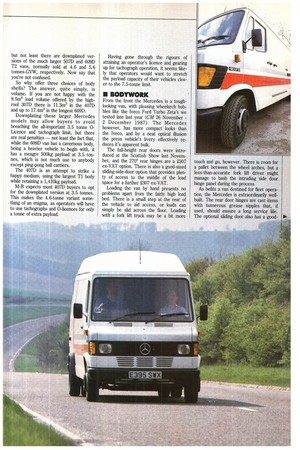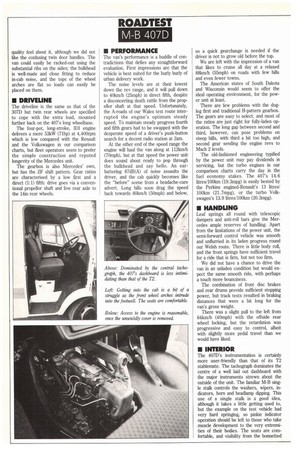BIG DOD BREMEN
Page 56

Page 57

Page 58

Page 59

If you've noticed an error in this article please click here to report it so we can fix it.
Mercedes-Benz vans have a reputation for reliability and longevity, and the 407 fills a gap in the range between the Ti and T2 families — but is it a gap that needs filling?
II There are times when manufacturers run the risk of confusing their customers by offering too many models. Take Mercedes-Benz for instance. When it comes to buying a diesel-powered panel van at 3.5 tonnes GVW, M-B(UK) has no fewer than three different models on its light commercial stall. First there is the 3.4m-wheelbase, single-rear-wheeled 307D "Bremen" Ti van, which can be supplied with either a high or low roof. Then there is the 3.7mwheelbase twin-rear-wheeled high-roof 407D Bremen, launched late last year, which is normally plated at 4.6 tonnes but can be downplated for 3.5 tonnes. Last but not least there are downplated versions of the much larger 507D and 609D 12 vans, normally sold at 4.6 and 5.6 tonnes-GVW, respectively. Now say that you're not confused.
So why offer three choices of body shells? The answer, quite simply, is volume. If you are not happy with the 9.5m3 load volume offered by the highroof 3071) there is 11.3m3 in the 407D and up to 17.4m3 in the longest 609D.
Downplating these larger Mercedes models may allow buyers to avoid breaching the all-important 3.5 tonne 0Licence and tachograph limit, but there are real penalties — not least the fact that, while the 609D van has a cavernous body, being a heavier vehicle to begin with, it has a meagre 500kg payload at 3.5 tonnes, which is not much use to anybody except ping-pang ball carriers.
The 407D is an attempt to strike a happy medium, using the largest Ti body while retaining a 1,410kg payload.
M-B expects most 4071) buyers to opt for the downplated version at 3.5 tonnes. This makes the 4.6-tonne variant something of an enigma, as operators will have to use tachographs and 0-licences for only a tonne of extra payload. Having gone through the rigours of attaining an operator's licence and gearing up for tachograph operation, it seems likely that operators would want to stretch the payload capacity of their vehicles closer to the 7.5-tonne limit.
• BODYWORK
From the front the Mercedes is a toughlooking van, with pleasing wheelarch bubbles like the Iveco Ford Turbo Zeta's we tested late last year (CM 26 November 2 December 1987). The Mercedes however, has more compact looks than the Iveco, and by a neat optical illusion the press vehicle's livery effectively reduces it's apparent bulk.
The full-height rear doors were introduced at the Scottish Show last November, and the 270° rear hinges are a 2307 ex-VAT option. There is also a good-sized sliding-side-door option that provides plenty of access to the middle of the load space for a further £307 ex-VAT.
Loading the van by hand presents no problems apart from the fairly high load bed. There is a small step at the rear of the vehicle to aid access, or loads can simply be slid across the floor. Loading with a fork lift truck may be a bit more touch and go, however. There is room for a pallet between the wheel arches, but a less-than-accurate fork lift driver might manage to bash the intruding side door hinge panel during the process.
As befits a van destined for fleet operation, the Mercedes is extraordinarily wellbuilt. The rear door hinges are cast items with numerous grease nipples that, if used, should ensure a long service life. The optional sliding door also has a good quality feel about it, although we did not like the confusing twin door handles. The van could easily be racked-out using the substantial ribs on the sides; the bulkhead is well-made and close fitting to reduce in-cab noise, and the tops of the wheel arches are flat so loads can easily be placed on them.
• DRIVEUNE
The driveline is the same as that of the 307D but twin rear wheels are specified to cope with the extra load, mounted further back on the 407's long wheelbase.
The four-pot, long-stroke, IDI engine delivers a mere 53kW (71hp) at 4,400rpm which is low compared with the Renault and the Volkswagen in our comparison charts, but fleet operators seem to prefer the simple construction and reputed longevity of the Mercedes unit.
The gearbox is also Mercedes' own, but has the ZF shift pattern. Gear ratios are characterised by a low first and a direct (1:1) fifth: drive goes via a conventional propellor shaft and live rear axle to the 14in rear wheels.
• PERFORMANCE
The van's performance is a huddle of contradictions that defies any straightforward evaluation. First impressions are that the vehicle is best suited for the burly burly of urban delivery work.
The noise levels are at their lowest down the rev range, and it will pull down to 40km/h (25mph) in direct fifth, despite a disconcerting death rattle from the propellor shaft at that speed. Unfortunately, the A-roads of our Wales test route interrupted the engine's optimum steady speed. To maintain steady progress fourth and fifth gears had to be swapped with the desperate speed of a driver's push-button search for a decent radio station at 2am.
At the other end of the speed range the engine will haul the van along at 1121cm/h (70mph), but at that speed the power unit does sound about ready to pop through the bulkhead and say hello. An earbattering 87dB(A) of noise assaults the driver, and the cab quickly becomes like the "before" scene from a headache-cure advert. Long hills soon drag the speed back towards 80km/h (50mph) and below, so a quick gearchange is needed if the driver is not to grow old before the top.
We are left with the impression of a van that likes to cruise all day at a relaxed 88km/h (55mph) on roads with few hills and even fewer towns.
The American states of South Dakota and Wisconsin would seem to offer the ideal operating environment, for the power unit at least.
There are few problems with the dogleg first and traditional H-pattern gearbox. The gears are easy to select, and most of the ratios are just right for fully-laden operation. The long gap between second and third, however, can pose problems on steep hills, with third a bit too high, and second gear sending the engine revs to Mach 2 levels.
The old-fashioned engineering typified by the power unit may pay dividends in servicing, but the turbo engines in our comparison charts carry the day in the fuel economy stakes. The 407's 14.6 litres/100Icm (19.3mpg) is easily bested by the Perkins engined-Renault's 13 litres/ 100km (21.7mpg), or the turbo Volkswagen's 13.9 litres/1001on (20.3mpg).
• HANDLING
Leaf springs all round with telescopic dampers and anti-roll bars give the Mercedes ample reserves of handling. Apart from the limitations of the power unit, the semi-forward control vehicle was smooth and unflurried in its laden progress round our Welsh route. There is little body roll, and the front springs have sufficient travel for a ride that is firm, but not too firm.
We did not have a chance to drive the van in an unladen condition but would expect the same smooth ride, with perhaps a touch more bounciness.
The combination of front disc brakes and rear drums provide sufficient stopping power, but track tests resulted in braking distances that were a bit long for the van's gross weight.
There was a slight pull to the left from 64km/h (40mph) with the offside rear wheel locking, but the retardation was progressive and easy to control, albeit with slightly more pedal travel than we would have hied.
• INTERIOR
The 407D's instrumentation is certainly more user-friendly than that of its T2 stablemate. The tachograph dominates the centre of a well laid out dashboard with the major instruments strewn about the outside of the unit. The familiar M-B single stalk controls the washers, wipers, indicators, horn and headlamp dipping. This use of a single stalk is a good idea, although it takes a little getting used to, but the example on the test vehicle had very hard springing, so pinkie indicator operation should be left to those who take muscle development to the very extremities of their bodies. The seats are comfortable, and visibility from the bonnetted cab is good, but we found the steering hard work at low speeds, and perhaps Mercedes should think about including power steering as standard.
• SUMMARY
The 3071) Ti van series has performed sterling service in this country with operators like Parceline and Elan. By nailing Mercedes to the wall on price the parcel firms have been able to take advantage of the reliability and longevity of a wellproven driveline.
Most of the work carried out by these vans involves bulk carriage at motorway speeds with little operation at their gross weight limit. A bigger version of the 307D van may appeal to operators specialising in this sort of work, especially in places like London where parcels traffic is heavy. The version they wold probably want, however, is the 3.5-tonne GVW model.
The 4.6-tonne GVW model is aimed at the elephants' graveyard between 3.5 and 7.5 tonnes, where sales are low and dealers are reluctant to take vehicles that could sit on their forecourts for ever. While the van performs competently, the engine is underpowered for fully-laden operation and it is unsociably noisy.
We would find it hard to justify the 407D at 4.6 tonnes, but its little 3.5-tonne sister could easily pass muster and compete strongly in what is a more competitive market sector.
0 by Andrew English
















































































































